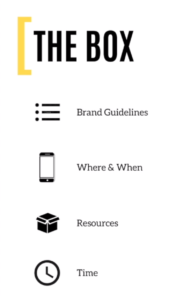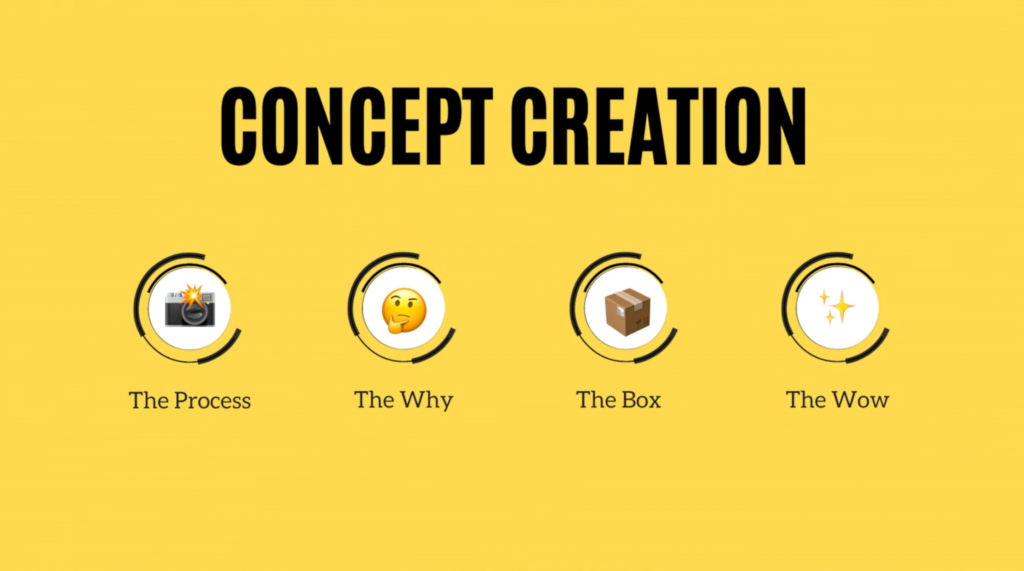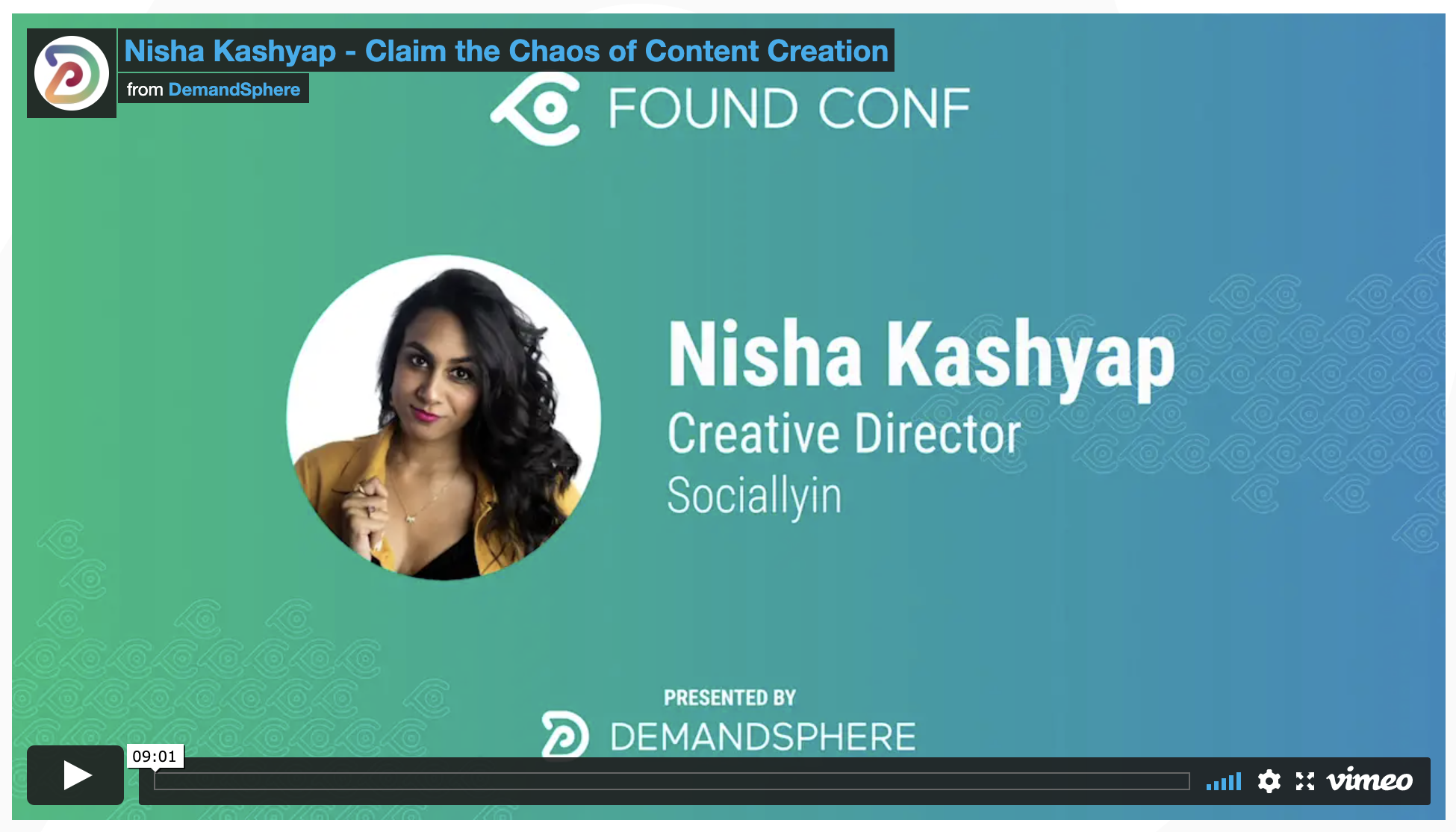The question comes up in every interview, clients demo, or panel meetup: “What’s your content creation process?” Some of us are all about Post-Its and planners, and some take a more…creative approach. But, how can your team be sure that it’s maximizing resources and creating usable, engaging marketing? It might be time to look beyond the flow of building ideas into emails, videos, blogs, and pages — what we think of as “content creation.” Concept creation — creating the unique backbone of your campaign — is a struggle for most of us. Nisha Kashup, creative director of Sociallyin, stopped by our virtual Found Conference to talk about what she calls “claiming the chaos of concept creation.”
Nisha says there are four key elements to concept creation — and that it’s up to your team to make each element work. Let’s talk about ways to make pieces that are uniquely yours, with an effective and efficient content creation process.
The Content Creation Process vs. the Concept Creation Process
Every team has different processes for content creation, but the basics remain the same. Your process likely includes brainstorming, execution, and review.. Whether you’re crafting an email or a YouTube ad, you need to create an idea, get it made, and test it.
Brainstorming
Nisha says brainstorming is the most important part of the creation process. Without a great idea, execution and delivery won’t amount to much. So, how can your team brainstorm its way to greatness? And, how can you keep a brainstorming session on track? Here are three things to consider:
- Determine who needs to be in your brainstorming session. How many people can get into this brainstorm session? How does each team member’s role and perspective add value to the brainstorm? Who else should be represented?
- What’s the process for your brainstorm? Are you adding ideas to a whiteboard? Should everyone brainstorm on their own and bring their ideas to the meet? Should you have an agenda or some kind of scrum procedure for your brainstorming event? Make sure you have the brainstorming process established before walking in.
- What do you want to get out of the brainstorming session? Do you need five ideas for infographics, or an outline for an entire video campaign? What parts of the braining Know what you want to have on-hand when you leave the brainstorming process.
Execution
Execution will look different for each project — and marketers should have a process for bringing ideas to life. Know your resources, and understand the role of each team member in creating branded content.
Review
The final review process is really important. Once you finish making your concept into something real, have a few eyes look over the product. You don’t want to wait until after your campaign launches to see that a typo ruined the execution of your awesome idea. Depending upon your content type, post-launch testing may be an option. For online content, A/B testing and tweaking provides a secondary layer of the review process — and can help you turn around a “meh” piece of content.
The “Why” of your content concept
The “why” should provide the backbone under your actual creation process. Why are you creating a new concept, and what do you want to get out of it? Is there a campaign coming up — say, a certain sales season or holiday — or is there a new product you want to get eyeballs on? Do you want to increase downloads, earn revenue, or up engagement? Every org — and even every campaign — looks for a different type of conversion.
Nisha recommends “keeping your eye on the why” throughout the concept creation process. Say you’re hoping to increase downloads of an app, and make a clean, engaging campaign to promote that app on social media — but don’t see an increase in downloads. Maybe you left off calls to action that speak specifically to app installs, or didn’t adjust the Instagram or Facebook default from “learn more” to “download now.” The “why” should inform your entire content creation experience — and point you to the right choices in testing, tracking, and reviewing.
The “Box”
Nisha calls the constraints placed on your new concept “the box.” These constraints may include time or budget limitations, branding must-dos, or confidentiality issues. By naming your boundaries, you’ll ensure your team makes the best use of your resources and your time. Keep these constraints in mind as you work through the creation process:
- Branding restrictions. Limitations to colors, fonts, and tone of voice ensure consistency throughout your deliverables. How can you make creative content that falls in line with those guidelines?
- The “where and when,” defines where the content lives and when it lands there. What medium are you using? Are you creating this content as part of a larger campaign?
- Resources: What kind of timeline and budget are you working with?
Nobody loves to be forced to think inside a box. But, setting parameters on your content helps you maximize your resources. Content creation isn’t about creating all of the content you’ll ever need: it’s about creating the right content for right now.

The big concept “Wow”
Another thread running through the creation process: the element that makes your concept stand out. There are plenty of ways to make your branded content unique, but you need to keep the “why” in the forefront of your mind as you flesh out that individuality. Nisha calls this element “the wow.”
Ride the right trends
Is there a new trend, and can you capitalize on it? Being one of the first brands to jump on a trend can be really important. Think about capitalizing on trending topics on social media, creating campaigns that nod to current events, or partnerships that make your brand particularly relevant.
Build upon your own brand
Once you have elements of the storyboard, how can you add interest to that piece? If you have a campaign that brought about recognition, how can you take that concept to the next level? You’ve come up with a great idea, a story board, and a beautiful concept. Try new channels, and don’t think that simple pieces can’t be built out. Nisha refers to one successful ad campaign that took a gorgeous product photo and upped the ante with animated, eye-catching graphics. The animation took the studio photos to that next level.
Know your superpower
What’s your superpower? Nisha says everyone has one — you just need to figure out what it is. Maybe you have an excellent illustrator on staff, or an amazing community that engages with you online. Find what works for you, and don’t be afraid to capitalize on that. After all: to create great content, you need to start with a great concept.


